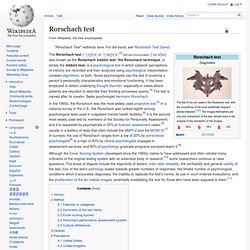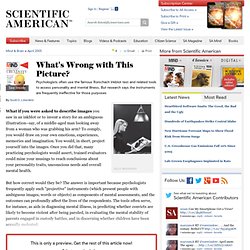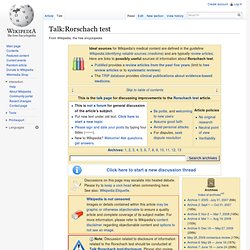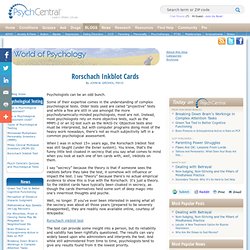

Rorschach test. The Rorschach test (/ˈrɔrʃɑːk/ or /ˈrɔərʃɑːk/,[3] German pronunciation: [ˈʁoːɐʃax]; also known as the Rorschach inkblot test, the Rorschach technique, or simply the inkblot test) is a psychological test in which subjects' perceptions of inkblots are recorded and then analyzed using psychological interpretation, complex algorithms, or both.

Some psychologists use this test to examine a person's personality characteristics and emotional functioning. It has been employed to detect underlying thought disorder, especially in cases where patients are reluctant to describe their thinking processes openly.[4] The test is named after its creator, Swiss psychologist Hermann Rorschach. Although the Exner Scoring System (developed since the 1960s) claims to have addressed and often refuted many criticisms of the original testing system with an extensive body of research,[10] some researchers continue to raise questions.
History Method The interpretation of a Rorschach record is a complex process. What's Wrong with This Picture? What if you were asked to describe images you saw in an inkblot or to invent a story for an ambiguous illustration--say, of a middle-aged man looking away from a woman who was grabbing his arm?

To comply, you would draw on your own emotions, experiences, memories and imagination. You would, in short, project yourself into the images. Once you did that, many practicing psychologists would assert, trained evaluators could mine your musings to reach conclusions about your personality traits, unconscious needs and overall mental health. But how correct would they be? The answer is important because psychologists frequently apply such "projective" instruments (which present people with ambiguous images, words or objects) as components of mental assessments, and the outcomes can profoundly affect the lives of the respondents. The Problem With the Rorschach: It Doesn't Work. TG Daily - Wikipedia blots its copybook. Online repository of questionable facts, Wikipedia, is in trouble with psychologists after publishing the 'answers' to the Rorschach inkblot tests.

Because the series of ink splodges was created by Swiss psychiatrist Hermann Rorschach back in 1921, their US copyright has expired and Wikipedia published the full set. Psychologists claim this is tantamount to publishing the answers to school examinations on the web. Initially Wikipedia had just one inkblot online, but last month, a Canadian doctor posted all ten blots into the Wikipedia article, together with the most popular responses for them.
Now psychologists argue that the site is jeopardising one of the oldest continuously used psychological assessment tests. Talk:Rorschach test. Efficacy misspelled[edit] Could an established editor please fix the spelling of "efficacy" (which is misspelled as "effiacy" in one section)?

— Preceding unsigned comment added by 138.69.160.1 (talk) 09:36, 8 November 2013 (UTC) Today's Google image[edit] ... involves an inkblot doodle, to commemmorate Rorschach's birth and this is discussed on various newspaper websites. Jackiespeel (talk) 16:12, 8 November 2013 (UTC) Well, it made in into Hermann Rorschach, which is probably quite appropriate, as it was the anniversary of the man, not the blots. Too detailed article can bias diagnosis and therapy[edit] Hello everybody, i'm a psychologist and i found this article very accurate, well written and detailed. Thanks for your comment, but have you seen all the above boxes? Polémica con la publicación del Test de Rorschach en Wikipedia - Recientemente el famoso Test de Rorschach que consta de 10 láminas con manchas de tinta creadas por el psiquiatra suizo Hermann Rorschach en 1921 han sido publicadas en Wikipedia [EN] junto con las respuestas más frecuentes o los detalles más importantes de las manchas.

Esto gracias a que este trabajo ha pasado a ser de dominio público en Estados Unidos ya que fue publicado antes del 1° de enero de 1923 (Post mortem auctoris). Este test usado por los psicólogos para evaluar la personalidad mediante el método proyectivo de psicodiagnóstico ya era de dominio público en 1992 que se habían cumplido 70 años de su muerte y en conformidad a la leyes de copyright suizas. Wikipedia's Inkblots: Normality in Tech and Medicine. Wikipedia is aflutter with angry psychologists demanding that the community take down reproductions of 10 original Rorschach inkblot plates and their statistically common responses.

The Rorschach tests have been used since the 1920's to determine psychological disorders through the analysis of images. Twenty-five percent of all forensic cases utilize the Rorschach test in assessing defendant competency and criminal responsibility. According to the New York Times, Dr. James Heilman of Moose Jaw, Saskatchewan originally uploaded the files and discussion has exploded ever since with doctors on both sides of the argument. Rorschach Inkblot Cards. Psychologists can be an odd bunch.

Some of their expertise comes in the understanding of complex psychological tests. Older tests used are called “projective” tests and while a few are still in use amongst the more psychodynamically-minded psychologists, most are not. Instead, most psychologists rely on more objective tests, such as the MMPI-2 or an IQ test such as the WAIS-IV. Objective tests also must be interpreted, but with computer programs doing most of the heavy work nowadays, there’s not as much subjectivity left in a common psychological assessment. Has Wikipedia Created a Rorschach Cheat Sheet? Analyze That - NY. Interestinf: Wikipedia vs Rorschach. As we noted here nearly a year ago, the Rorschach Inkblot Test images have been made available on Wikipedia.

This is not a big deal, since it’s what’s called a projective test, meaning that the images themselves are not important — it’s what you see in the images that can be interesting to a psychologist. Yesterday, The New York Times noted the controversy, which has a new twist.